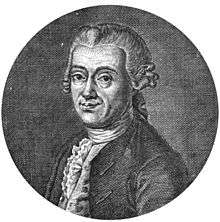Johann Daniel Titius
| Johann Daniel Titius | |
|---|---|
 Johann Daniel Titius | |
| Born |
Johann Daniel Tietz January 2, 1729 Konitz, Royal Prussia, (Chojnice, Poland) |
| Died |
December 11, 1796 (aged 67) Wittenberg, Electorate of Saxony |
| Nationality | German |
| Fields | Astronomy, Physics, Biology |
| Known for | Titius–Bode law |
Johann Daniel Titius born Johann Daniel Tietz(e) (January 2, 1729 – December 11, 1796) was a German astronomer and a professor at Wittenberg.[1]
Titius was born in Konitz, Royal Prussia to Jakob Tietz, a merchant and council member from Konitz, and Maria Dorothea, née Hanow. His original name was Johann Tietz, but as was customary in the 18th century, when he became a university professor, he Latinized his surname to Titius. Tietz attended school in Danzig (Gdańsk) and studied at the University of Leipzig (1749-1752). He died in Wittenberg, Electorate of Saxony.[1]
Astronomy
He is best known for formulating the Titius–Bode law, and for using this rule to predict the existence of a celestial object at 2.8 AU from the sun. This happened in 1766, when he inserted his observation on planetary distances into a German translation of Charles Bonnet's book Contemplation de la Nature. His suggestion that the object would necessarily be small was later superseded by the claim of Johann Elert Bode for a planet-like object, subsequently identified as being Ceres. In part because of the Titius-Bode law, the first four minor planets were at first labeled full-fledged planets. After a fifteen-year hiatus, other minor planets started to be discovered at steadily increasing rates, and Ceres and company were eventually relabeled "minor planets" or "asteroids". Because of its spherical shape, Ceres was reclassified as a dwarf planet in 2006.
The asteroid 1998 Titius and the crater Titius on the Moon are named in his honour.[2][3]
Physics
Titius published a number of works on other areas in Physics, such as a set of conditions and rules for performing experiments, and he was particularly focused in thermometry.[4] In 1765 he presented a survey of thermometry up to that date. He wrote about the metallic thermometer constructed by Hanns Loeser. In his treatises on both theoretical and experimental physics, he incorporated the findings of other scientists, such as the descriptions of experiments written by Georg Wolfgang Kraft in 1738.[5]
Biology
Titius was also active in Biology, particularly in classification of organisms and minerals.[4] His biological work was influenced by Linnaeus. Lehrbegriff der Naturgeschichte Zum ersten Unterrichte, his most extensive publication in Biology, was on systematic classification of plants, animals, and minerals, as well as the elemental substances ether, light, fire, air, and water.[5]
References
- 1 2 sächsische Biografie (German)
- ↑ Michael Nieto (1972). The Titius–Bode Law of Planetary Distances. Pergamon Press.
- ↑ Clifford J. Cunningham (1988). Introduction to Asteroids. Richmond, Virginia: Willmann-Bell Inc.
- 1 2 "Johann Daniel Titius". Encyclopædia Britannica (online ed.). Encyclopædia Britannica, Inc.
- 1 2 "Titius (Tietz), Johann Daniel". Complete Dictionary of Scientific Biography (e-book ed.). New York: Charles Scribner's Sons. 2007. Retrieved 6 August 2015.
- ↑ "Author Query for 'Titius'". International Plant Names Index.
External links
- KDG Wittenberg: Prof. Dr. Joh. Daniel Titius
- Plants and Planets: The Law of Titius-Bode explained by H.J.R. Perdijk
- "Johann Daniel Titius", Allgemeine Deutsche Biographie (ADB) (in German) 38, Leipzig: Duncker & Humblot, 1894, pp. 380–
|